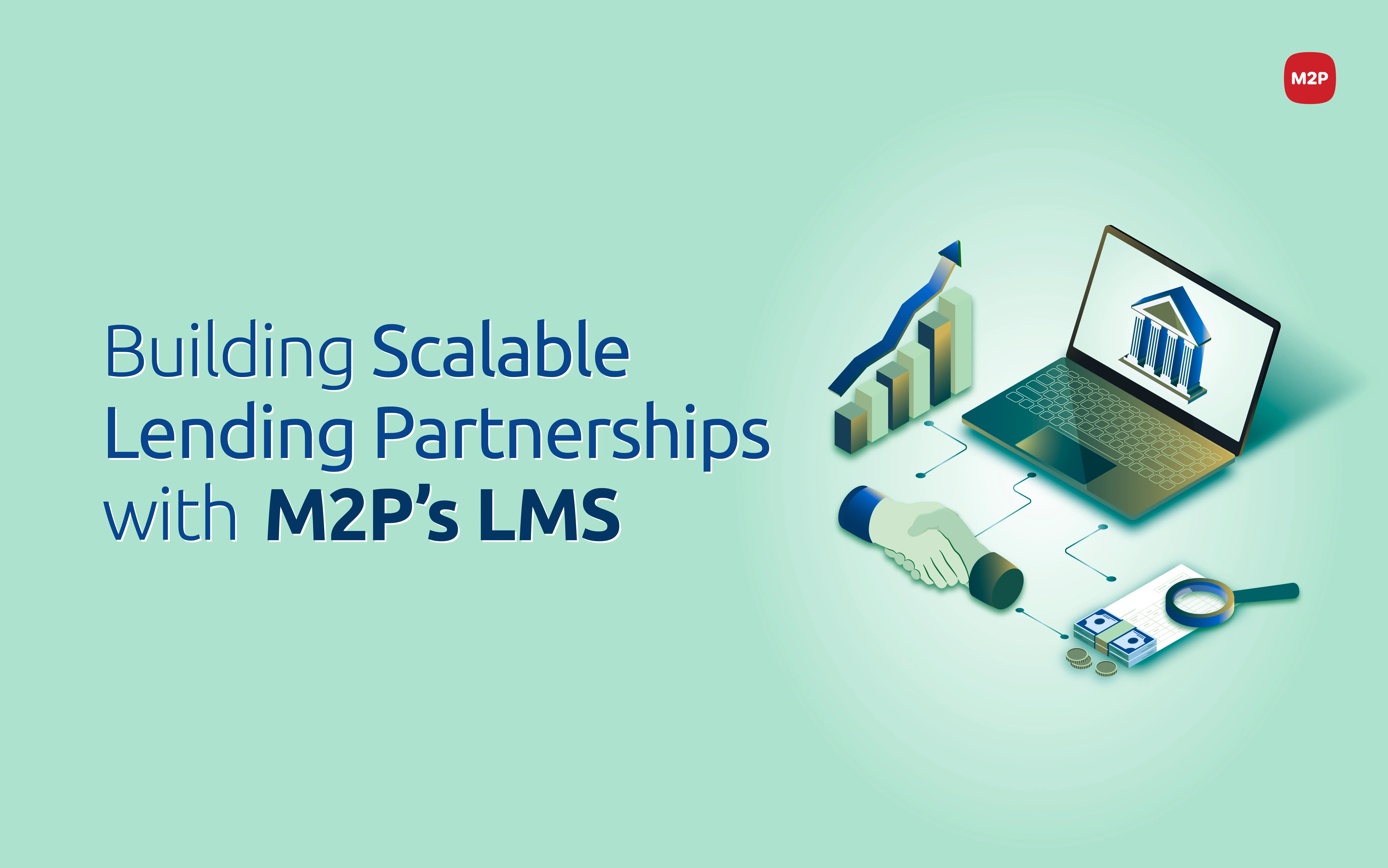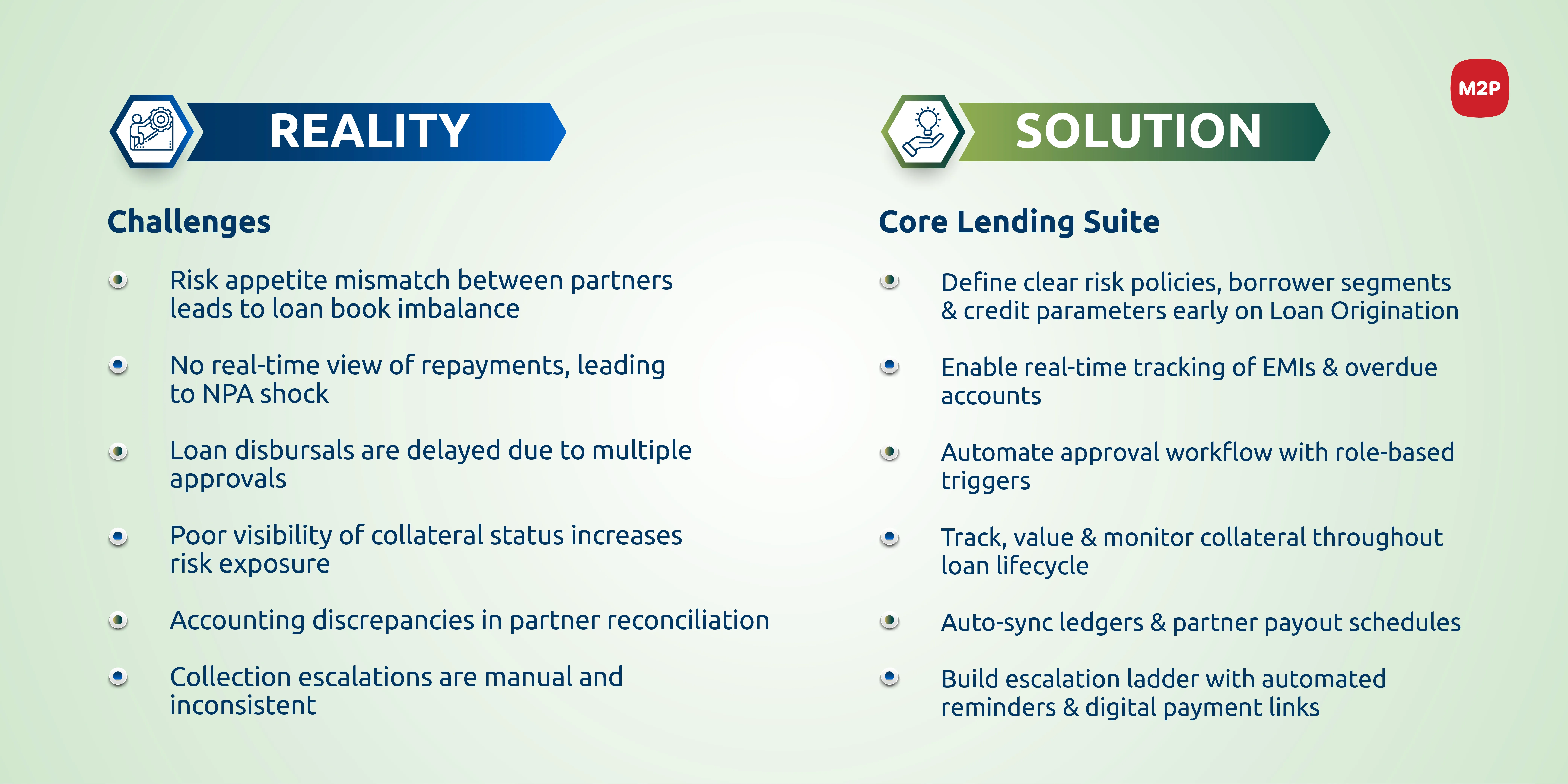
M2P Fintech
Fintech is evolving every day. That's why you need our newsletter! Get the latest fintech news, views, insights, directly to your inbox every fortnight for FREE!

India’s digital lending landscape is experiencing explosive growth, with the market forecast to reach an impressive USD 515 billion by 2030. Yet, beneath this meteoric rise, many rural entrepreneurs, underserved communities, and first-time borrowers still struggle to gain fair access to credit.
This is where co-lending emerges as a transformative force.
By enabling financial institutions to collaborate more effectively, co-lending opens doors to broader credit access, risk-sharing, and agile lending ecosystems. It empowers financial institutions to broaden their reach and deliver a lending experience that’s quicker, more efficient, and accessible to a wider range of borrowers.
In this blog, we will explore the limitations hindering traditional lending partnerships and demonstrate how M2P's innovative Loan Management System (LMS) is paving the way for efficient and future-ready co-lending solutions.
Let first dive into the barriers of traditional lending partnerships.
Even the most well-intentioned lending partnerships collapse due to structural misalignments, unclear ownership, and divergent risk philosophies. Below are some of the key challenges that frequently undermine these collaborations.
Partners often differ in their approach to risk. One may prioritize rapid borrower acquisition, while the other leans toward conservative underwriting leading to friction, delayed launches, and inconsistent portfolio outcomes.
Disagreements around Loan-to-Value (LTV) ratios, Debt-to-Income (DTI) thresholds, and borrower eligibility criteria stall credit policy alignment. This becomes especially problematic during product expansion or scale-up phases.
When scorecards, rules engines, and approval workflows are poorly integrated, one partner may approve loans that fall outside the other risk framework, increasing exposure and eroding trust.
Multi-party signoffs and unclear ownership of post-verification steps often delay disbursals. These inefficiencies not only frustrate customers but also impact conversion rates and partner confidence.
If one party focuses solely on origination while the other bears the burden of collections and risk management, the partnership becomes unsustainable, especially when default rates rise.
Ambiguity around who owns KYC, AML, and regulatory compliance during disbursal exposes both entities to legal and reputational risks, particularly in tightly regulated markets.
Disjointed borrower journeys with handoffs between systems or support teams lead to confusion, drop-offs, and diminished trust.
Co-lending offers a way forward. By enabling banks and NBFCs to jointly fund loans, it creates a shared-risk, shared-reward model that’s more resilient and inclusive. The RBI’s support for co-lending has accelerated adoption, and the results speak volumes. Loan disbursements under co-lending surged 134% in FY24, reflecting growing institutional confidence. This co-lending model solves key pain points:
Technology alignment via shared platforms
Operational efficiency via streamlined workflows
Broader reach through NBFC networks
Risk mitigation through joint underwriting
Yet, as promising as co-lending is, its success depends on flawless execution. To truly scale and sustain these partnerships, financial institutions need a robust, flexible infrastructure that simplifies collaboration without compromising control.
M2P’s API-first, cloud-native Loan Management System (LMS) is purpose-built to support modern co-lending ecosystems. Designed for flexibility and speed, it enables banks, NBFCs, and fintechs to seamlessly integrate their operations, automate workflows, and manage joint lending portfolios with precision. Its modular architecture allows partners to go onboard quickly, configure co-lending rules, and maintain real-time visibility across the loan lifecycle from origination to servicing and collections.
Here’s how M2P’s Loan Management System (LMS) directly addresses each co-lending challenge, transforming complexity into opportunity.
When multiple lenders (banks, NBFCs, and fintechs) collaborate; they often operate with distinct systems, workflows, and risk frameworks. This lack of standardization leads to daily coordination issues, miscommunication, and operational inefficiencies, making it difficult to manage joint lending portfolios effectively.
Modular, API-First Architecture: M2P’s LMS is designed to integrate easily with different partner systems, automating data flow and task management between organizations.
Role-Based Access & Audit Logs: Our LMS platform tracks every user action and tightly controls permissions, ensuring only authorized personnel can perform sensitive operations. This transparency and accountability are essential for multi-entity partnerships.
Managing multiple repayment schedules and frequent schedule revisions is a major hurdle in co-lending. Lenders often use different interest calculation methods (e.g., 30/360 vs. Actual/365), and borrowers regularly request changes such as part-prepayments, restructurings, or rate adjustments. This complexity can lead to reconciliation issues, delays, and disputes if not handled seamlessly.
Triple Schedule Engine: M2P’s LMS supports independent repayment schedules for each stakeholder (borrower, NBFC, bank), ensuring all parties’ requirements are met and synchronized.
Lender-Specific Day Count Conventions: Our LMS allows each lender to set their preferred interest calculation method, guaranteeing precise and compliant interest computations.
Dynamic Schedule Management: M2P’s LMS enables real-time, flexible handling of schedule revision, such as part-prepayments, foreclosures, and rate change, automatically recalculating balances and interest for all parties.
Instant Synchronization: Our LMS ensures all schedule changes are instantly reflected across partner systems, reducing delays and eliminating inconsistencies.

Receipt handling, accounting complexity, and regulatory reporting are deeply intertwined in co-lending. Splitting incoming payments, maintaining accurate three-way ledgers, and meeting stringent compliance requirements (like real-time statements and audit trails) can overwhelm finance teams and introduce risk.
Automated Risk-Based Payment Allocation: Our LMS platform automatically splits incoming payments among lenders based on predefined risk-sharing ratios, ensuring error-free and dispute-free reconciliation.
Integrated Voucher & GL Entry Engine: M2P’s LMS automates voucher creation and general ledger entries for all transactions, streamlining financial reporting and audit readiness.
Real-Time Data & Comprehensive Audit Logs: Our LMS platform maintains up-to-date records and detailed audit trails, simplifying compliance with regulatory mandates and enabling quick, accurate reporting.
Integrated Accounting Dashboard: M2P’s LMS provides finance teams with a centralized view of all co-lending transactions, risk-sharing, and compliance metrics, reducing manual workload and ensuring transparency.
In co-lending arrangements, risk is distributed across multiple financial institutions such as banks, NBFCs, and fintechs. While this shared model offers broader reach and diversified exposure, it also introduces significant challenges in monitoring loan performance and detecting early signs of distress or fraud. Each partner may have its own risk assessment framework, monitoring tools, and escalation protocols. This lack of uniformity can result in delayed identification of non-performing assets (NPAs), missed red flags, and inconsistent responses to borrower defaults. Moreover, fragmented data visibility across systems makes it difficult to track anomalies in real time, increasing the likelihood of financial losses and reputational damage.
Centralized Monitoring & Risk Allocation: M2P’s Loan Management System offers real-time visibility into loan performance and risk-sharing arrangements, enabling early detection of anomalies or defaults and supporting proactive risk management.
For many lenders, expanding into new or underserved markets presents a significant challenge. These regions often lack the digital infrastructure, credit history data, or established customer relationships that lenders rely on for risk assessment and operational efficiency. Additionally, entering these markets typically requires deep local insights, agile onboarding processes, and scalable systems that can handle diverse borrower profiles and loan types. Without these capabilities, lenders face high operational costs, slow go-to-market timelines, and increased risk exposure. This lack of agility and infrastructure limits their ability to serve high-potential segments.
Seamless end-to-end co-lending management: Our advanced Loan Management System (LMS) is purpose-built to digitize and automate the entire co-lending lifecycle from loan origination to servicing and collections on a single, unified platform. It enables seamless collaboration between banks, NBFCs, and fintech partners by offering real-time data sharing, configurable workflows, and automated reconciliation across multiple lending arrangements.
But how does this robust LMS framework come together in practice? Let’s explore how M2P’s Loan Management System works for co-lending.
M2P’s’s LMS (Loan Management System) offers a streamlined, tech-driven approach to manage co-lending from start to finish. Let’s break down how it works.
It all begins with defining the partnership. M2P’s allows lenders to be onboard quickly, and co-lending agreements are digitally configured—setting the stage for collaboration.
Each lender has a different appetite for risk and revenue. M2P’s LMS allows you configure how the loan risk and charges are split between the primary and secondary lenders.
Once approved, the loan is disbursed by the primary lender, while our LMS system ensures all parties are notified and aligned.
M2P’s Loan Management System automatically generates three repayment schedules, for the borrower, the bank, and the NBFC, based on their respective conventions (e.g., 30/360 vs Actual/365).
As repayments come in, our LMS system allocates them instantly across lenders using pre-configured logic. Whether it’s an interest-first or proportional split, the system handles it all.
When loans are closed or prepaid, M2P’s LMS ensures all ledgers are updated, payouts are settled, and reports are generated for compliance and audit.
During loan origination, our LMS system integrates with external Loan Origination Systems (LOS) to allow dynamic lender selection based on product, geography, or risk profile.
Lenders can approve loans via API, SFTP, or bulk upload, making the process flexible.
M2P’s Loan Management System auto-generates documents tailored to each lender’s format, whether it’s sanction letters, repayment schedules, or SOAs.
Repayments are split based on pre-set rules, principle-first, interest-first, or custom logic, ensuring fairness and accuracy.
Our LMS system supports CLM1-compliant disbursement, ensuring regulatory alignment and smooth fund flow between lenders and borrowers.
M2P’s Loan Management System simplifies operations, ensures compliance, and empowers lenders to scale faster and smarter.
As co-lending becomes mainstream, M2P’s LMS is redefining the landscape with powerful, future-ready features that simplify complexity and unlock new growth opportunities.
Here’s a glimpse of what sets us apart.
Multi-Lender Orchestration for Platform-Led Distribution
Real-Time Reconciliation Dashboard with MIS Auto-Triggers
Configurable APIs for External LOS & Escrow Systems
Pre-Built Templates for RBI CLM Reports
These capabilities are more than just features; they’re enablers. They help lenders:
Scale co-lending operations without friction
Maintain transparency across partners
Reduce operational overhead
Serve new markets with confidence
Proven Lending Tech for NBFCs & Banks -Trusted by financial institutions for delivering scalable, secure, and smart lending solutions.
Co-Lending Native LMS - Purpose-built Loan Management System designed to handle multi-lender workflows with ease.
RBI-Ready Customizations - Tailored implementation aligned with regulatory norms and partner bank SOPs.
Modular & Scalable Architecture - Grow your co-lending business with a flexible platform that evolves with your strategy.
Whether you’re looking to streamline operations, ensure compliance, or unlock new growth opportunities, our Loan Management System (LMS) empowers your team to deliver seamless, future-ready lending experiences.
Ready to future proof your co-lending operations?
Book a personalized demo with us today.
Subscribe to our newsletter and get the latest fintech news, views, and insights directly to your inbox.
Follow us on LinkedIn and Twitter for insightful fintech bytes curated for curious minds like you.